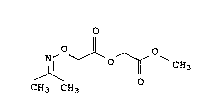Some of the information on this Web page has been provided by external sources. The Government of Canada is not responsible for the accuracy, reliability or currency of the information supplied by external sources. Users wishing to rely upon this information should consult directly with the source of the information. Content provided by external sources is not subject to official languages, privacy and accessibility requirements.
Any discrepancies in the text and image of the Claims and Abstract are due to differing posting times. Text of the Claims and Abstract are posted:
| (12) Patent Application: | (11) CA 2161063 |
|---|---|
| (54) English Title: | PREPARATION OF METHYL ISOPROPYLIDENEAMINOOXYACETOXYACETATE |
| (54) French Title: | PREPARATION D'ISOPROPYLIDENEAMINOOXYACETOXYACETATE |
| Status: | Deemed Abandoned and Beyond the Period of Reinstatement - Pending Response to Notice of Disregarded Communication |
| (51) International Patent Classification (IPC): |
|
|---|---|
| (72) Inventors : |
|
| (73) Owners : |
|
| (71) Applicants : |
|
| (74) Agent: | ROBIC AGENCE PI S.E.C./ROBIC IP AGENCY LP |
| (74) Associate agent: | |
| (45) Issued: | |
| (22) Filed Date: | 1995-10-20 |
| (41) Open to Public Inspection: | 1996-04-23 |
| Availability of licence: | N/A |
| Dedicated to the Public: | N/A |
| (25) Language of filing: | English |
| Patent Cooperation Treaty (PCT): | No |
|---|
| (30) Application Priority Data: | ||||||
|---|---|---|---|---|---|---|
|
Process for preparing methyl isopropylideneaminooxyacetoxyacetate
I
<IMG> I
by reacting in an integrated process, without isolation of inter-
mediates,
a) acetone with hydroxylammonium sulfate and sodium hydroxide
solution to give acetone oxime, the reaction being performed
in the presence of toluene and/or the acetone oxime being
extracted from the reaction mixture with toluene,
b) treating the toluene solution thus obtained with sodium
hydroxide solution and removing water,
c) exchanging toluene for a dipolar aprotic solvent by distilla-
tion,
d) reacting the crystal mash thus obtained with the sodium salt
of chloroacetic acid to give the sodium salt of isopro-
pylideneaminooxyacetic acid and then treating the reaction
mixture with methyl chloroacetate and
e) isolating the methyl isopropylideneaminooxyacetoxyacetate in
a manner known per se.
Note: Claims are shown in the official language in which they were submitted.
Note: Descriptions are shown in the official language in which they were submitted.

2024-08-01:As part of the Next Generation Patents (NGP) transition, the Canadian Patents Database (CPD) now contains a more detailed Event History, which replicates the Event Log of our new back-office solution.
Please note that "Inactive:" events refers to events no longer in use in our new back-office solution.
For a clearer understanding of the status of the application/patent presented on this page, the site Disclaimer , as well as the definitions for Patent , Event History , Maintenance Fee and Payment History should be consulted.
| Description | Date |
|---|---|
| Inactive: IPC from MCD | 2006-03-12 |
| Time Limit for Reversal Expired | 2003-10-20 |
| Application Not Reinstated by Deadline | 2003-10-20 |
| Inactive: Status info is complete as of Log entry date | 2002-12-31 |
| Inactive: Abandon-RFE+Late fee unpaid-Correspondence sent | 2002-10-21 |
| Deemed Abandoned - Failure to Respond to Maintenance Fee Notice | 2002-10-21 |
| Application Published (Open to Public Inspection) | 1996-04-23 |
| Abandonment Date | Reason | Reinstatement Date |
|---|---|---|
| 2002-10-21 |
The last payment was received on 2001-09-18
Note : If the full payment has not been received on or before the date indicated, a further fee may be required which may be one of the following
Please refer to the CIPO Patent Fees web page to see all current fee amounts.
| Fee Type | Anniversary Year | Due Date | Paid Date |
|---|---|---|---|
| MF (application, 2nd anniv.) - standard | 02 | 1997-10-20 | 1997-10-01 |
| MF (application, 3rd anniv.) - standard | 03 | 1998-10-20 | 1998-09-24 |
| MF (application, 4th anniv.) - standard | 04 | 1999-10-20 | 1999-09-27 |
| MF (application, 5th anniv.) - standard | 05 | 2000-10-20 | 2000-09-20 |
| MF (application, 6th anniv.) - standard | 06 | 2001-10-22 | 2001-09-18 |
Note: Records showing the ownership history in alphabetical order.
| Current Owners on Record |
|---|
| BASF AKTIENGESELLSCHAFT |
| Past Owners on Record |
|---|
| JOSEF WAHL |
| MICHAEL KEIL |